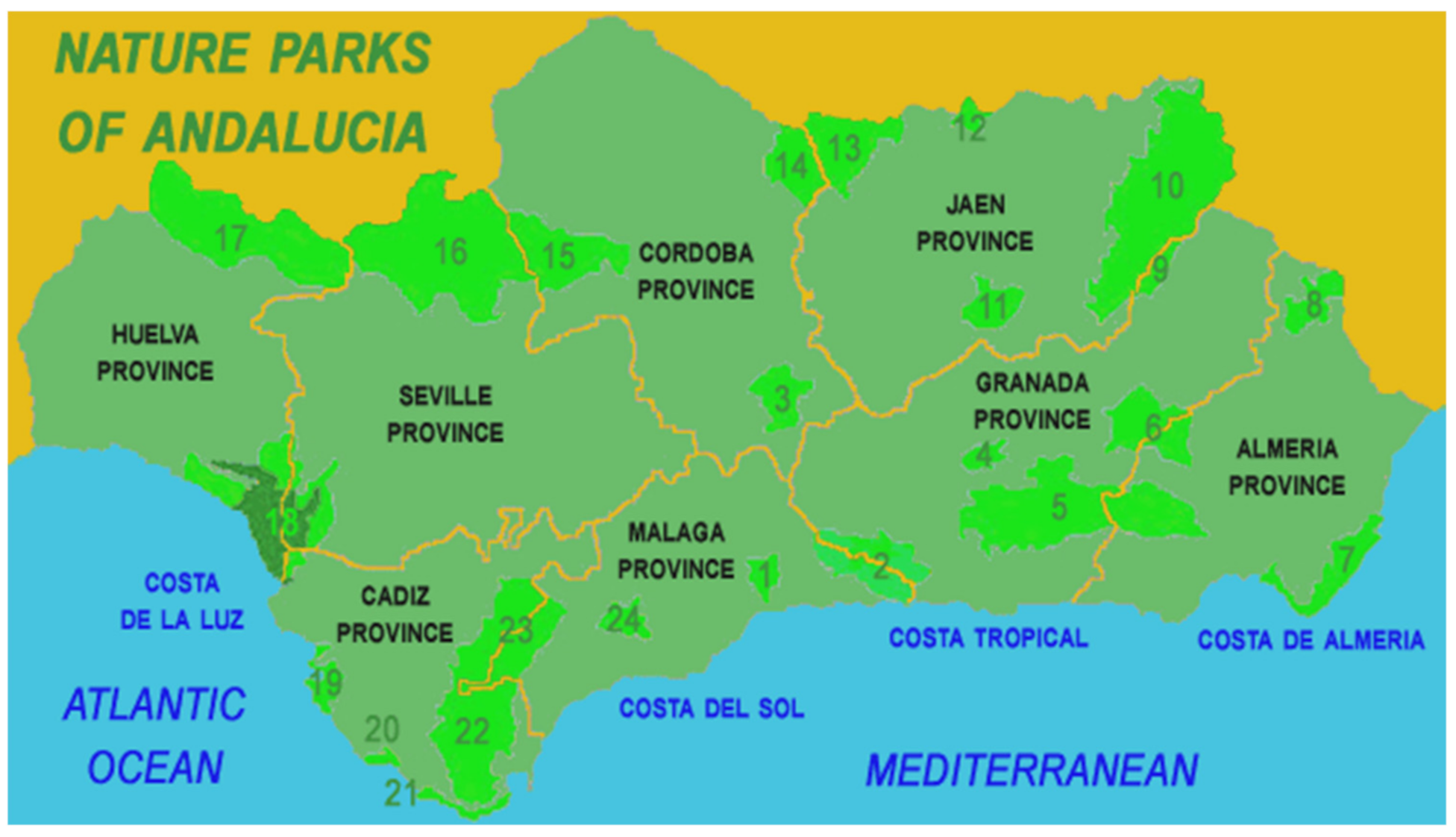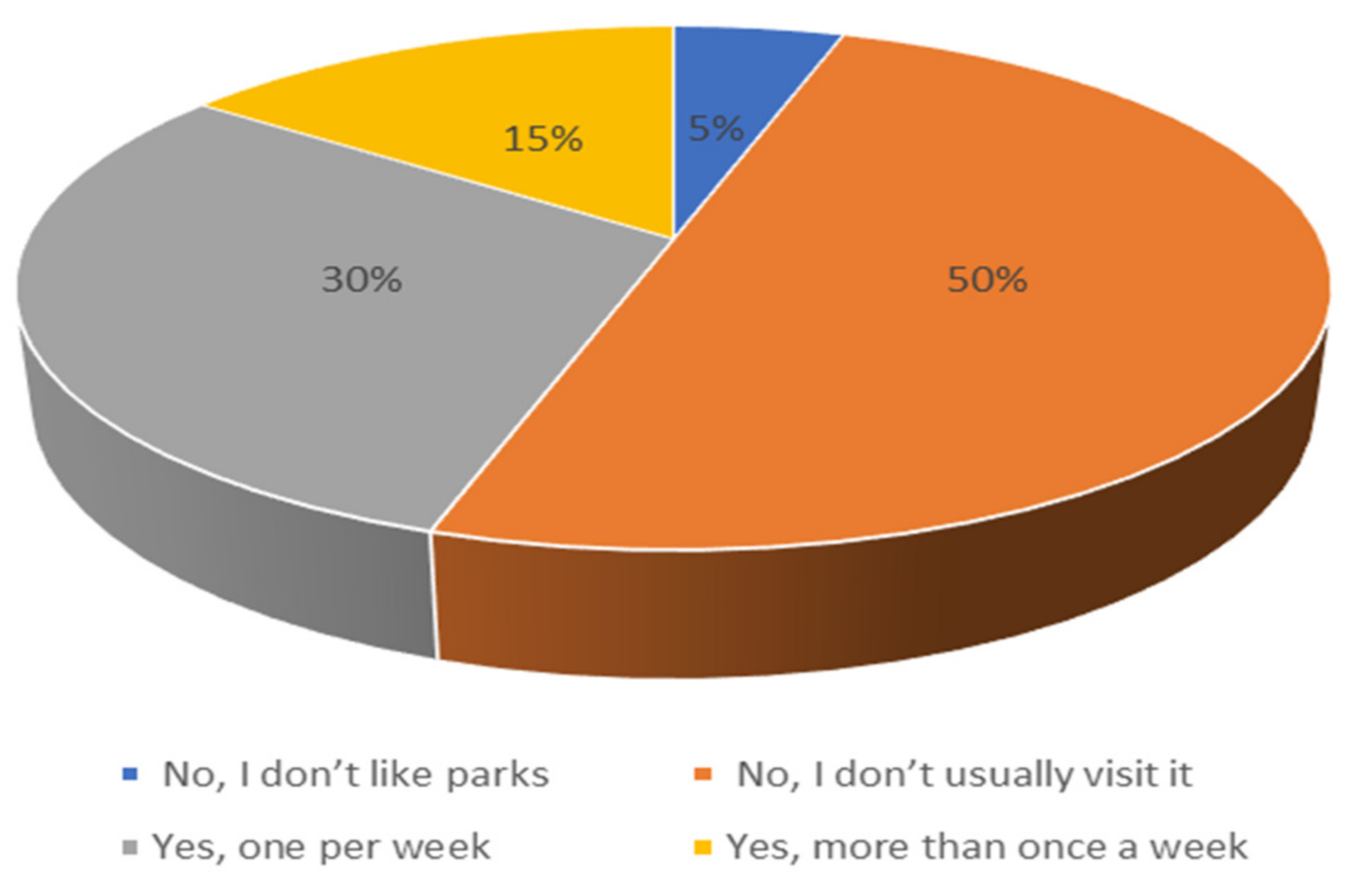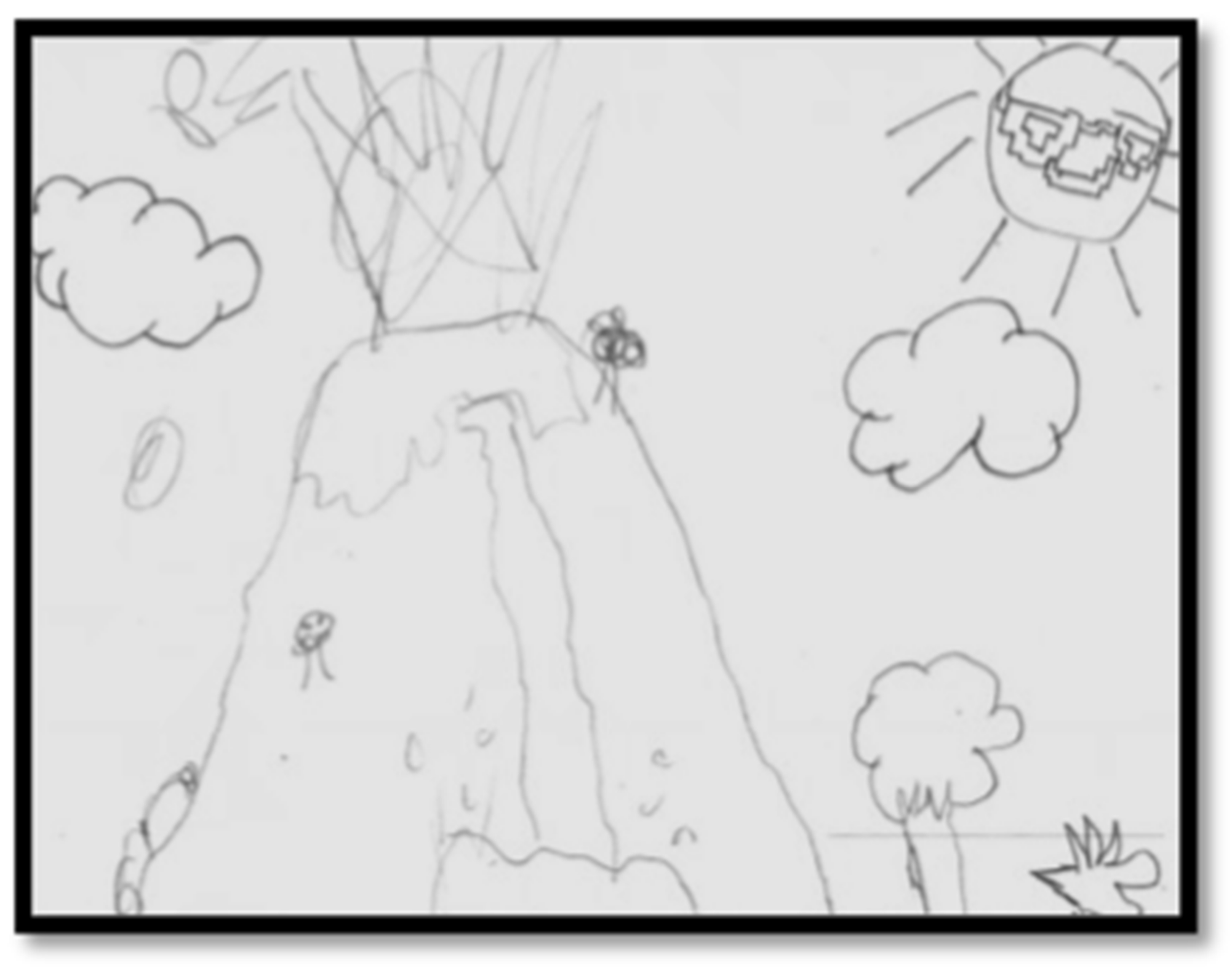How Do Children Perceive the Biodiversity of Their nearby Environment: An Analysis of Drawings
Abstract
1. Introduction
2. Spanish Curriculum Background: Biodiversity in Primary School and Science Education
3. Materials and Methods
3.1. Participants and Socio-Cultural Context of the Schools
3.2. Data Sources and Procedure
3.3. Data Analysis
4. Results
5. Discussion
6. Conclusions and Teaching Implications
7. Limitations of the Study
Author Contributions
Funding
Institutional Review Board Statement
Informed Consent Statement
Data Availability Statement
Conflicts of Interest
References
- Morin, E. Introduction à la Pensée Complexe; Seuil Editorial: Paris, France, 1990. [Google Scholar]
- Hodson, D. Becoming part of the solution: Learning about activism, learning through activism, learning from activism. In Activist Science and Technology Education; Bencze, J.L., Alsop, S., Eds.; Springer: Dordrecht, The Netherlands, 2014; pp. 67–98. [Google Scholar]
- Morón-Monge, H.; Morón-Monge, M.C.; Abril-López, D.; Daza Navarro, M.P. An Approach to Prospective Primary School Teachers’ Concept of Environment and Biodiversity through their Design of Educational Itineraries: Validation of an Evaluation Rubric. Sustainability 2020, 12, 5553. [Google Scholar] [CrossRef]
- Daza Navarro, M.; Morón-Monge, H.; Daza Navarro, P. El trabajo por proyectos en educación secundaria obligatoria: Tres Visiones, Tres Generaciones (Experiencias). Rev. Andin. Educ. 2020, 3, 32–40. [Google Scholar]
- Escobero Rodríguez, J.M. La Biodiversidad y su transposición didáctica en el currículo de Primaria en las Leyes Orgánicas de Educación desde la LOGSE (1990). Rev. Educ. Ambient. Sostenibilidad 2020, 2, 1303. [Google Scholar] [CrossRef]
- United Nations. Convention on Biological Diversity (with Annexes); Concluded at Rio de Janeiro on 5 June 1992, United Nations—Treaty Series; United Nations: New York, NY, USA, 1993; pp. 142–382. [Google Scholar]
- Programa de Naciones Unidas para el Medio Ambiente (PNUMA). Perspectivas del Medio Ambiente Mundial. GEO 3, Pasado, Presente y Futuro; Ediciones Mundi-Prensa: Madrid, Spain, 2002; pp. 214–215. [Google Scholar]
- Myers, N.; Mittermeier, R.A.; Mittermeier, C.G.; Da Fonseca, G.A.; Kent, J. Biodiversity hotspots for conservation priorities. Nature 2000, 403, 853–858. [Google Scholar] [CrossRef]
- Campos, P.; Caparrós, A.; Oviedo, J.L.; Ovando, P.; Álvarez-Farizo, B.; Díaz-Balteiro, L.; Martínez-Peña, F. Bridging the gap between national and ecosystem accounting application in andalusian forests, Spain. Ecol. Econ. 2019, 157, 218–236. [Google Scholar] [CrossRef]
- Lindemann-Matthies, P.; Constantinou, C.; Junge, X.; Köhler, K.; Mayer, J.; Nagel, U.; Kadji-Beltran, C. The integration of biodiversity education in the initial education of primary school teachers: Four comparative case studies from Europe. Environ. Educ. Res. 2009, 15, 17–37. [Google Scholar] [CrossRef]
- Navarro-Perez, M.; Tidball, K.G. Challenges of biodiversity education: A review of education strategies for biodiversity education. Int. Electron. J. Environ. Educ. 2012, 2, 13–30. [Google Scholar]
- Schneiderhan-Opel, J.; Bogner, F.X. Between environmental utilization and protection: Adolescent conceptions of biodiversity. Sustainability 2019, 11, 4517. [Google Scholar] [CrossRef]
- National Research Council (NRC). National Science Education Standards; The National Academy Press: Washington, DC, USA, 1996. [Google Scholar]
- National Research Council (NRC). A Framework for K-12 Science Education: Practices, Crosscutting Concepts, and Core Ideas. Committee on a Conceptual Framework for New K-12 Science Education Standards. Board on Science Education, Division of Behavioral and Social Sciences and Education; The National Academies Press: Washington, DC, USA, 2012. [Google Scholar]
- Keeley, P. Formative Assessment Probes: Uncovering Young Children’s Concept of a Plant. Sci. Child. 2017, 55, 20–22. [Google Scholar] [CrossRef]
- Eshach, H.; Fried, M.N. Should Science be Taught in Early Childhood? J. Sci. Educ. Technol. 2005, 14, 315–336. [Google Scholar] [CrossRef]
- Cantó, J.; Pro Bueno, A.; Solbes, J. Qué ciencias se enseñan y cómo se hace en las aulas de educación infantil? La visión de los maestros en formación inicial. Enseñanza Cienc. 2016, 34, 25–50. [Google Scholar]
- Mazas, B.; Gil-Quílez, M.J.; Martínez-Peña, B.; Hervás, A.; Muñoz, A. Los niños de infantil piensan, actúan y hablan sobre el comportamiento del aire y del agua. Enseñanza Cienc. 2018, 36, 163–180. [Google Scholar]
- Tal, R.T.; Morag, O. Reflective practice as a means for preparing to teach outdoors in ecological garden. J. Sci. Teach. Educ. 2009, 20, 245–262. [Google Scholar] [CrossRef]
- Harris, I. Outdoor Education in Secondary Schools: What Future? Horizons 1999, 4, 5–8. [Google Scholar]
- Sandell, K.; Öhman, J. Educational potentials of encounters with nature: Reflections from a Swedish outdoor perspective. Environ. Educ. Res. 2010, 16, 113–132. [Google Scholar] [CrossRef]
- Waite, S. Teaching and learning outside the classroom: Personal values, alternative pedagogies and standards. Education 2011, 39, 65–82. [Google Scholar] [CrossRef]
- Gelter, H. Friluftsliv: The Scandinavian philosophy of outdoor life. Can. J. Environ. Educ. 2000, 5, 77–92. [Google Scholar]
- Dillon, J.; Rickinson, M.; Teamey, K.; Morris, M.; Choi, M.Y.; Sanders, D.; Benefield, P. The value of outdoor learning: Evidence from research in the UK and elsewhere. Sch. Sci. Rev. 2006, 87, 107. [Google Scholar]
- Dyment, J.E. Green school grounds as sites for outdoor learning: Barriers and opportunities. Int. Res. Geogr. Environ. Educ. 2005, 14, 28–45. [Google Scholar] [CrossRef]
- Ulker, R. Turkish children’s drawing of nature in a certain way: Range of mountains in the back, the sun, couple of clouds, a river rising from the mountains. Educ. Sci. Theory Pract. 2012, 12, 3173–3180. [Google Scholar]
- White, R.; Gunstone, R. Probing Understanding, 4th ed.; The Falmer Press: London, UK, 2000. [Google Scholar]
- Ahi, B. The world of plants in children’s drawings: The color preference and the effect of age and gender on these preferences. J. Baltic Sci. Educ. 2017, 16, 32–42. [Google Scholar]
- Flowers, A.E.; Carroll, J.P.; Green, G.T.; Larson, L.R. Using art to assess environmental education outcomes. Environ. Educ. Res. 2015, 21, 846–864. [Google Scholar] [CrossRef]
- Campos, C.B.D.; Santos, A.C.D.; Sarriera, J.C.; Bomfim, Z.Á.C.; Fedrizzi, B. Percepción de la naturaleza por niños de contextos urbano y costero: Un análisis de dibujos y palabras clave. Rev. Latinoam. Med. Conduct. 2014, 4, 31–40. [Google Scholar]
- Farokhi, M.; Hashemi, M. The analysis of children’s drawings: Social, emotional, physical, and psychological aspects. Procedia Soc. Behav. Sci. 2011, 30, 2219–2224. [Google Scholar] [CrossRef]
- Torres-Nerio, R.; Domínguez-Cortinas, G.; van’t Hooft, A.; Díaz-Barriga Martínez, F.; Cubillas-Tejeda, A.C. Análisis de la percepción de la exposición a riesgos ambientales para la salud, en dos poblaciones infantiles, mediante la elaboración de dibujos. Salud Colect. 2010, 6, 65–81. [Google Scholar] [CrossRef]
- Morón-Monge, H.; Wamba, A.M. La Percepción sobre los Riesgos Ambientales como Indicador de los Obstáculos y Dificultades para la Construcción de un Concepto de Medio Ambiente Responsable. Biogr. Escr. Sobre Biol. Enseñanza 2010, 3, 1–24. [Google Scholar] [CrossRef]
- Flores, R.C.; Reyes, L.H. Estudio sobre las percepciones y la educación ambiental. Tiempo Educ. 2010, 11, 227–249. [Google Scholar]
- Martínez-Peña, M.B.; Gil-Quílez, M.J. Drawings as a tool for understanding geology in the environment. J. Geosci. Educ. 2014, 62, 701–713. [Google Scholar] [CrossRef]
- Terrado, P.R.; Fuertes, E.R. La percepción infantil del entorno próximo. In Análisis Espacial y Representación Geográfica: Innovación y Aplicación; En de la Riva, J., Ibarra, P., Montorio, R., Rodrigues, M., Eds.; Departamento de Geografía y Ordenación del Territorio, Universidad de Zaragoza-AGE: Zaragoza, Spain, 2015; pp. 1485–1494. [Google Scholar]
- Villarroel, J.D.; Antón, A.; Zuazagoitia, D.; Nuño, T. A Study on the Spontaneous Representation of Animals in Young Children’s Drawings of Plant Life. Sustainability 2018, 10, 1000. [Google Scholar] [CrossRef]
- Capel, H. Percepción del medio y comportamiento geográfico. Rev. Geogr. 1973, 7, 58–150. [Google Scholar]
- Kalvaitis, D.; Monhardt, R.M. The architecture of children’s relationships with nature: A phenomenographic investigation seen through drawings and written narratives of elementary students. Environ. Educ. Res. 2012, 18, 209–227. [Google Scholar] [CrossRef]
- Stokas, D.; Strezou, E.; Malandrakis, G.; Papadopoulou, P. Greek primary school children’s representations of the urban environment as seen through their drawings. Environ. Educ. Res. 2017, 23, 1088–1114. [Google Scholar] [CrossRef]
- Beltran Sierra, N.I. Componentes del concepto naturaleza: Análisis de dibujos Elaborados por Niños de Preescolar de Entorno Desértico. Master’s Thesis, Universidad de Sonora, Sonora, Mexico, 2019. [Google Scholar]
- Gallant, R.A. Pitfalls of personification. Sci. Child. 1981, 19, 16–17. [Google Scholar]
- Solís-Espallargas, C.; Morón-Monge, H. How to Improve Sustainability Competences of Teacher Training? Inquiring the Prior Knowledge on Climate Change in Primary School Students. Sustainability 2020, 12, 6486. [Google Scholar] [CrossRef]
- García Gómez, J.; Martínez, F.J. Cómo y qué enseñar de la biodiversidad en la alfabetización científica. Enseñanzae Cienc. Rev. Investig. Exp. Didácticas 2010, 28, 175–184. [Google Scholar]
- Caurín, A.; Martínez, M.J. Análisis del concepto de biodiversidad en los libros de texto de segundo ciclo de primaria en la Comunidad Valenciana (España). Perf. Educ. 2013, 35, 97–114. [Google Scholar]
- Organic Law 2/2006, 3 May on Education, Boletín Oficial del Estado, 106, Madrid, Spain. 2006; pp. 17158–17207. Available online: https://www.boe.es/buscar/pdf/2006/BOE-A-2006-7899-consolidado.pdf (accessed on 1 March 2021).
- Organic Law 8/2013, 9 December, for the improvement of educational quality; Ministerio de la Presidencia, Boletín Oficial del Estado, 295, Madrid, Spain. 2013; pp. 97858–97921. Available online: https://www.boe.es/boe/dias/2013/12/10/pdfs/BOE-A-2013-12886.pdf (accessed on 1 March 2021).
- De Ramirez, R.D.; Edward, S.S. Curriculum-based measurement and the evaluation of reading skills of Spanish-speaking English language learners in bilingual education classrooms. Sch. Psychol. Rev. 2006, 35, 356–369. [Google Scholar] [CrossRef]
- Decreto 97/2015, de 3 de marzo, por el que se establece la ordenación y el currículo de la Educación Primaria en la Comunidad Autónoma de Andalucía; Boletín Oficial de la Junta de Andalucía: Andalucia, Spain, 2015; pp. 11–22.
- Cohen, L.; Manion, L.; Morrison, K. Research Methods in Education, 6th ed.; Routledge Falmer: London, UK; New York, NY, USA, 2007. [Google Scholar]
- Mayring, P. Qualitative Content Analysis. Theoretical Foundation, Basic Procedures and Software Solution; Social Science Open Access Repository SSOAR, URN: Klagenfurt, Austria, 2014. [Google Scholar]
- Baxter, P.; Jack, S. Qualitative case study methodology: Study design and implementation for novice researchers. Qual. Rep. 2008, 13, 544–559. [Google Scholar]
- Cengizoğlu, S.; Olgan, R.; Teksöz, G. Preschool children’s perceptions on human–environment relationship: Follow-up Research. Early Child Dev. Care 2020, 1–22. [Google Scholar] [CrossRef]
- Piaget, J. Child’s Conception of the World; Littlefield Adams: Savage, MD, USA, 1951. [Google Scholar]
- Anderson, J.L.; Ellis, J.P.; Jones, A.M. Understanding Early Elementary Children’s Conceptual Knowledge of Plant Structure and Function through Drawings. CBE Life Sci. Educ. 2014, 13, 375–386. [Google Scholar] [CrossRef] [PubMed]
- Merewether, J. New materialisms and children’s outdoor environments: Murmurative diffractions. Child. Geogr. 2019, 17, 105–117. [Google Scholar] [CrossRef]
- Leiva, F.M.; Rios, F.J.M.; Martínez, T.L. Assessment of interjudge reliability in the open-ended questions coding process. Qual. Quant. 2006, 40, 519–537. [Google Scholar] [CrossRef]
- Cabezas Rabadán, C. Relación Entre las Características de las playas y el Perfil, Preferencias y Percepción de sus Osuarios. Master’s Thesis, Universidad Politecnica De Valencia, Valencia, Spain, 2014. [Google Scholar]
- Costillo, E.; Borrachero, A.B.; Villalobos, A.M.; Mellado, V.; Sánchez, J. Utilización de la modelización para trabajar salidas al medio natural en profesores en formación de educación secundaria. Biogr. Escr. Sobre Biol. Enseñanza 2014, 7, 165–175. [Google Scholar]
- Zamalloa, T.; Sanz, J.; Maguregi, G.; Echevarría, I.; Fernández, L. Acercar la geodiversidad a través de las salidas de campo en la ESO. Una investigación con el profesorado de ciencias de Bizkaia. Enseñanza Cienc. Rev. Investig. Exp. Didácticas 2014, 32, 443–467. [Google Scholar]
- Estepa, J.E.; Ferreras, M.; Morón-Monge, M.C. Resultados de investigación sobre concepciones del profesorado y gestores del patrimonio y análisis de libros de texto y materiales didácticos de los museos y centros de interpretación del patrimonio. In La Educación patrimonial en la escuela y el museo: Investigación y experiencias; Estepa, J.E., Ed.; Universidad de Huelva: Andalusia, Spain, 2013; pp. 25–39. [Google Scholar]
- Fernández-Ferrer, G.; González-García, F. Salidas de campo y desarrollo competencial. Enseñanza Cienc. Tierra 2017, 25, 295. [Google Scholar]
- Morón, H.; Morón Monge, M.C. La evolución del concepto de patrimonio: Oportunidades para la enseñanza de las Ciencias. Didáctica Cienc. Exp. Soc. 2017, 33, 83–98. [Google Scholar]
- Özsoy, S.; Ahi, B. Elementary School Students’ Perceptions of the Future Environment through Artwork. Educ. Sci. Theory Pract. 2014, 14, 1570–1582. [Google Scholar] [CrossRef]
- Günindi, Y. Environment in My Point of View: Analysis of the Perceptions of Environment of the Children Attending to Kindergarten through the Pictures They Draw. Procedia Soc. Behav. Sci. 2012, 55, 594–603. [Google Scholar] [CrossRef]
- Llorente-Adán, J. Análisis del conocimiento que los alumnos de primaria de un municipio riojano tienen de su propia localidad. Propuesta didáctica para favorecer la exploración y la mejor comprensión de su pueblo. In La reconfiguración del medio rural en la sociedad de la información. Nuevos desafíos en la Educación Geográfica; Macía, X., Armas, F., Rodríguez, F., Eds.; Andavira Editora S.L.: Santiago de Compostela, Spain, 2019; pp. 1249–1260. [Google Scholar]
- Morón, H.; Hamed, S.; Morón, M.C. Cómo usan los futuros maestros de ciencias el medio socio-natural en el diseño de Itinerarios didácticos?: Algunos resultados y obstáculos de aprendizaje. In Investigación, Innovación Docente y TIC. Nuevos Horizontes Educativos; Alonso, S., Romero, J.M., Rodríguez-Jiménez, C., Sola, J.M., Eds.; Dykinson: Madrid, Spain, 2019; pp. 1754–1768. [Google Scholar]
- Cruz-Guzmán, M.; Puig Gutiérrez, M.; García-Carmona, A. ¿Qué tipos de actividades diseñan e implementan en el aula futuros docentes de Educación Infantil cuando enseñan ciencia mediante rincones de trabajo? Enseñanza Cienc. 2020, 38, 0027–0045. [Google Scholar]
- Maynard, T.; Chicken, S. Through a different lens: Exploring Reggio Emilia in a Welsh context. Early Years 2010, 30, 29–39. [Google Scholar] [CrossRef]
- James, J.K.; Williams, T. School-based experiential outdoor education: A neglected necessity. J. Exp. Educ. 2017, 40, 58–71. [Google Scholar] [CrossRef]
- Dimitrijević, J.; Filipović, S.; Stanisavljević, J. An analysis of students’ drawings for the purpose of considering the efficiency of teamwork (programme content: Marine life community). J. Subj. Didact. 2016, 1, 25–38. [Google Scholar]
- Loureiro, K.S.; Grecu, A.; de Moll, F. Analyzing Drawings to Explore children’s Concepts of an Ideal School: Implications for the Improvement of children’s Well-Being at School. Child Ind. Res. 2020, 13, 1387–1411. [Google Scholar] [CrossRef]











| Question | Type | |
|---|---|---|
| (1) Frequency: Do you usually visit Guadaira Park? | Closed and dichotomous question (Yes/Not) with four options:
| |
| (2) Frequency: How many times have you visited nature (the beach, countryside, mountains, etc.) in the last month? | Closed question with four options:
| |
| (3) Preferences: Which is your favorite natural place? | (3a) Write a story | Open question |
| (3b) Draw a picture | Open question | |
| Categories | Sub-Categories | Descriptors | |||
|---|---|---|---|---|---|
| I. Typology of environment: level of environmental alteration | Anthropized environment | Urban parks, zoos, aquariums, urban gardens, in which artificial elements predominate. | |||
| Mixed | Rural | Fields, agricultural and/or livestock areas, pasture systems, reservoirs, that combine natural elements and others typical of human agricultural and/or livestock activity. | |||
| Coast | Beaches, estuaries, coastal cliffs, etc., with infrastructure (access and/or leisure) or close to urban centers. | ||||
| Natural environment | Mountain areas, valleys, lagoons, marshes, wooded areas, and other areas far from urban centers and/or with little alteration, whether they are protected at the legislative level. | ||||
| II. Environment Descriptors: main characteristics of the drawings | Animism | Assigning human qualities to inanimate objects. For example, the Sun, the Moon, etc., are represented with smiling faces/animals or plants have anthropomorphic forms. | |||
| Elements that predominate | Anthropic | Elements of human origin, including whether they are associated with economic activities of an industrial, agricultural (wells and fences, etc.), recreational (camping), urban, etc. nature. | |||
| Biological | Fauna | Natural animal elements of three types: wild, domestic, and fantastical or mythological. | |||
| Flora | Natural plant elements of three types: herbaceous, shrubby and arboreal. | ||||
| Geological | Geological elements from landforms to geological elements, such as mountain slopes, valleys, beaches, sheets of water, rocks, etc. | ||||
| Contextualization: Location and representation | The elements represented respond to geographical and temporal issues. There is integration between the elements and logic in their spatial relationships. The drawing is contextualized (C): in an urban park, as a general context, swings, fountains, children playing, etc., are drawn. On the contrary, the drawing is decontextualized (DC): for example, a child has drawn a mountain where there are sharks or natural elements that do not correspond to the ecosystem of the place at a spatial or temporal level. | ||||
| Naturalness Level | General Environment (n) | Specific Environment (n) | Total Frequency | % Total | |
|---|---|---|---|---|---|
| Anthropized environment | 24 | 10 | 34 | 28.5 | |
| Mixed | rural | 9 | 6 | 15 | 43 |
| coast | 26 | 11 | 37 | 25 | |
| Natural environment | 24 | 10 | 34 | 28.5 | |
| TOTAL | 83 | 37 | 120 | 100 | |
| Elements that Predominate | General: Pictures Quantity | List of Type of Elements | |
|---|---|---|---|
| A. Anthropic | 33% |
| |
| B. Biological | Fauna | 19% |
|
| Flora | 31% |
| |
| C. Geological | 17% |
| |
Publisher’s Note: MDPI stays neutral with regard to jurisdictional claims in published maps and institutional affiliations. |
© 2021 by the authors. Licensee MDPI, Basel, Switzerland. This article is an open access article distributed under the terms and conditions of the Creative Commons Attribution (CC BY) license (http://creativecommons.org/licenses/by/4.0/).
Share and Cite
Morón-Monge, H.; Hamed, S.; Morón Monge, M.d.C. How Do Children Perceive the Biodiversity of Their nearby Environment: An Analysis of Drawings. Sustainability 2021, 13, 3036. https://doi.org/10.3390/su13063036
Morón-Monge H, Hamed S, Morón Monge MdC. How Do Children Perceive the Biodiversity of Their nearby Environment: An Analysis of Drawings. Sustainability. 2021; 13(6):3036. https://doi.org/10.3390/su13063036
Chicago/Turabian StyleMorón-Monge, Hortensia, Soraya Hamed, and María del Carmen Morón Monge. 2021. "How Do Children Perceive the Biodiversity of Their nearby Environment: An Analysis of Drawings" Sustainability 13, no. 6: 3036. https://doi.org/10.3390/su13063036
APA StyleMorón-Monge, H., Hamed, S., & Morón Monge, M. d. C. (2021). How Do Children Perceive the Biodiversity of Their nearby Environment: An Analysis of Drawings. Sustainability, 13(6), 3036. https://doi.org/10.3390/su13063036






